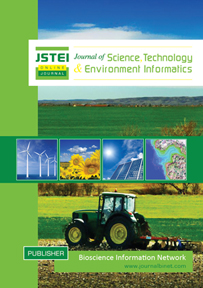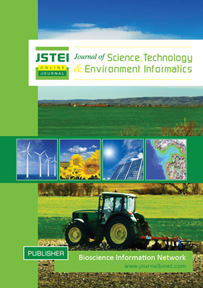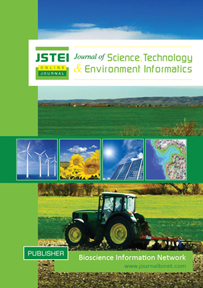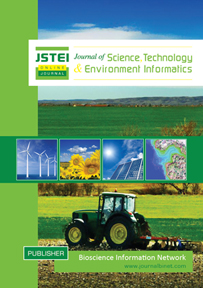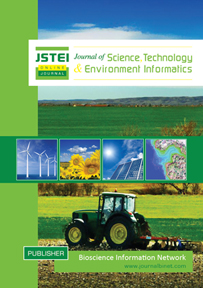Journal of Science, Technology and Environment Informatics
Volume 13 - Issue 01 | Year of Publication: 2024
Article Type: Review Article | No. 83, 2024 | Country: Bangladesh | pp. 827-839 | Open Access
Title: Arsenic pollution and its impact on agricultural production, including the ecosystem services delivered by biodiversity
Authors: Hoque, M. M., Rahman, S., Hoque, M. E., Ara, M. J. and Jamal, M. R.
DOI: http://dx.doi.org/10.18801/jstei.130124.83
Title: Arsenic pollution and its impact on agricultural production, including the ecosystem services delivered by biodiversity
Authors: Hoque, M. M., Rahman, S., Hoque, M. E., Ara, M. J. and Jamal, M. R.
DOI: http://dx.doi.org/10.18801/jstei.130124.83
Arsenic pollution and its impact on agricultural production, including the ecosystem services delivered by biodiversity
Abstract
Arsenic (As), a noxious metal(loid) widely available in the biosphere, originates mainly from geogenic and anthropogenic origin. Massive global development and industrialization, using pesticides carrying arsenic, arsenical animal feeds, medicine, mining, aquifer sediments, coal burning, and microbial and natural processes continuously release this obnoxious bane to the natural environment and pollute soil and water. Inorganic (iAs) species, mainly arsenate and arsenite, are comparatively more lethal than methylated species. However, pentavalent [As (V)] organic species are nearly non-toxic. An elevated level of arsenic has been found in various crops and feeds consumed by humans and animals. This notable carcinogen threatens human health by drinking arsenic-polluted freshwater and/or ingesting arsenic-adulterated food like cereals, fruits and vegetables grown in arsenic-polluted soil or grown using arsenic-rich irrigation water. Arsenic pollution exerts an irreversible harmful effect on the aquatic and terrestrial ecosystem as well. Much research has been carried out in the last couple of centuries on arsenic pollution and reported its ability to influence the agro-ecosystem to a great extent, including plant accumulation, phytotoxicity, and land degradation. However, underground water is considered the principal source of arsenic pollution, Iron plaque, sulphur oxides, organic matter, microbiome activities and many other factors responsible for speciation, bioavailability and toxicity of As to the environment. This review attempts to comprehend the global arsenic pollution occurrence, its forms, bioavailability and toxicity to humans and microbiota, translocation and accumulation in plants and impact on crop yield. Besides providing the insights, the ultimate targets of this desktop study are to ascertain probable knowledge gaps linked to crop productivity and ecosystem benefit losses that need further investigation.
Key Words: Ecotoxicity, Ecosystem services, Microbiome, Yield loss, Phytotoxicity and Amelioration.
Abstract
Arsenic (As), a noxious metal(loid) widely available in the biosphere, originates mainly from geogenic and anthropogenic origin. Massive global development and industrialization, using pesticides carrying arsenic, arsenical animal feeds, medicine, mining, aquifer sediments, coal burning, and microbial and natural processes continuously release this obnoxious bane to the natural environment and pollute soil and water. Inorganic (iAs) species, mainly arsenate and arsenite, are comparatively more lethal than methylated species. However, pentavalent [As (V)] organic species are nearly non-toxic. An elevated level of arsenic has been found in various crops and feeds consumed by humans and animals. This notable carcinogen threatens human health by drinking arsenic-polluted freshwater and/or ingesting arsenic-adulterated food like cereals, fruits and vegetables grown in arsenic-polluted soil or grown using arsenic-rich irrigation water. Arsenic pollution exerts an irreversible harmful effect on the aquatic and terrestrial ecosystem as well. Much research has been carried out in the last couple of centuries on arsenic pollution and reported its ability to influence the agro-ecosystem to a great extent, including plant accumulation, phytotoxicity, and land degradation. However, underground water is considered the principal source of arsenic pollution, Iron plaque, sulphur oxides, organic matter, microbiome activities and many other factors responsible for speciation, bioavailability and toxicity of As to the environment. This review attempts to comprehend the global arsenic pollution occurrence, its forms, bioavailability and toxicity to humans and microbiota, translocation and accumulation in plants and impact on crop yield. Besides providing the insights, the ultimate targets of this desktop study are to ascertain probable knowledge gaps linked to crop productivity and ecosystem benefit losses that need further investigation.
Key Words: Ecotoxicity, Ecosystem services, Microbiome, Yield loss, Phytotoxicity and Amelioration.
HOW TO CITE THIS ARTICLE
MLA
Hoque, M. M. et al. “Arsenic pollution and its impact on agricultural production, including the ecosystem services delivered by biodiversity”. Journal of Science, Technology and Environment Informatics 12(02) (2024): 827-839.
APA
Hoque, M. M., Rahman, S., Hoque, M. E., Ara, M. J. and Jamal, M. R. (2024). Arsenic pollution and its impact on agricultural production, including the ecosystem services delivered by biodiversity. Journal of Science, Technology and Environment Informatics, 12(02), 827-839.
Chicago
Hoque, M. M., Rahman, S., Hoque, M. E., Ara, M. J. and Jamal, M. R. “Arsenic pollution and its impact on agricultural production, including the ecosystem services delivered by biodiversity” Journal of Science, Technology and Environment Informatics 12(02) (2024): 827-839.
Harvard
Hoque, M. M., Rahman, S., Hoque, M. E., Ara, M. J. and Jamal, M. R. 2024. Arsenic pollution and its impact on agricultural production, including the ecosystem services delivered by biodiversity. Journal of Science, Technology and Environment Informatics, 12(02), pp. 827-839.
Vancouver
Hoque, MM, Rahman, S, Hoque, ME, Ara, MJ and Jamal, MR. Arsenic pollution and its impact on agricultural production, including the ecosystem services delivered by biodiversity. Journal of Science, Technology and Environment Informatics. 2024 February, 12(02): 827-839.
MLA
Hoque, M. M. et al. “Arsenic pollution and its impact on agricultural production, including the ecosystem services delivered by biodiversity”. Journal of Science, Technology and Environment Informatics 12(02) (2024): 827-839.
APA
Hoque, M. M., Rahman, S., Hoque, M. E., Ara, M. J. and Jamal, M. R. (2024). Arsenic pollution and its impact on agricultural production, including the ecosystem services delivered by biodiversity. Journal of Science, Technology and Environment Informatics, 12(02), 827-839.
Chicago
Hoque, M. M., Rahman, S., Hoque, M. E., Ara, M. J. and Jamal, M. R. “Arsenic pollution and its impact on agricultural production, including the ecosystem services delivered by biodiversity” Journal of Science, Technology and Environment Informatics 12(02) (2024): 827-839.
Harvard
Hoque, M. M., Rahman, S., Hoque, M. E., Ara, M. J. and Jamal, M. R. 2024. Arsenic pollution and its impact on agricultural production, including the ecosystem services delivered by biodiversity. Journal of Science, Technology and Environment Informatics, 12(02), pp. 827-839.
Vancouver
Hoque, MM, Rahman, S, Hoque, ME, Ara, MJ and Jamal, MR. Arsenic pollution and its impact on agricultural production, including the ecosystem services delivered by biodiversity. Journal of Science, Technology and Environment Informatics. 2024 February, 12(02): 827-839.
Article Type: Research Article | No. 84, 2024 | Country: Bangladesh | pp. 840-849 | Open Access
Title: Performance of shallow tube well irrigation system at Ghatail upazila in Bangladesh
Authors: Hossain, S. M. I. and Oliver, M. M. H.
DOI: http://dx.doi.org/10.18801/jstei.130124.84
Title: Performance of shallow tube well irrigation system at Ghatail upazila in Bangladesh
Authors: Hossain, S. M. I. and Oliver, M. M. H.
DOI: http://dx.doi.org/10.18801/jstei.130124.84
Performance of shallow tube well irrigation system at Ghatail upazila in Bangladesh
Abstract
This study evaluated the performance of shallow tube well (STW) irrigation system at Ghatail upazila in Tangail district of Bangladesh. Secondary data were collected from the office of upazila agriculture officer at Ghatail. Primary data were collected from the STWs owners through a questionnaire. The discharge and other parameters were directly measured for some selected STWs in the field. About 91.7% of the irrigated land of the upazila is irrigated by STW irrigation system. Remaining 7.98% and 0.32% are irrigated by deep tube well (DTW) and Low lift pump (LLP) irrigation systems, respectively. During 2013-2022, a limited increase in number of DTW, STW and LLP was found, which caused an insignificant overall increase of irrigated area of 0.74% only. However, LLP showed a higher overall increase in both units (20% for diesel engines and 66.67% for electric motors) and area coverage (41.38%). Average discharge and area coverage of the selected STWs were found to be 12.31 l/s and 3.32 ha per STW, respectively. The average area coverage of STW installed on low land was 3.97 ha/STW, while that of high land was 1.91 ha/STW. The electric motor powered STW showed higher area coverage (3.61 ha/STW) than the diesel engine powered STW (3.56 ha/STW). The average water use efficiency (WUE) was found to be 42.7% which was relatively very low. However, adopting appropriate resource conserving crop management practices and supervising low coverage and water use efficiency could significantly improve.
Key Words: Performance, Shallow Tube Well (STW), Groundwater and Irrigation
Abstract
This study evaluated the performance of shallow tube well (STW) irrigation system at Ghatail upazila in Tangail district of Bangladesh. Secondary data were collected from the office of upazila agriculture officer at Ghatail. Primary data were collected from the STWs owners through a questionnaire. The discharge and other parameters were directly measured for some selected STWs in the field. About 91.7% of the irrigated land of the upazila is irrigated by STW irrigation system. Remaining 7.98% and 0.32% are irrigated by deep tube well (DTW) and Low lift pump (LLP) irrigation systems, respectively. During 2013-2022, a limited increase in number of DTW, STW and LLP was found, which caused an insignificant overall increase of irrigated area of 0.74% only. However, LLP showed a higher overall increase in both units (20% for diesel engines and 66.67% for electric motors) and area coverage (41.38%). Average discharge and area coverage of the selected STWs were found to be 12.31 l/s and 3.32 ha per STW, respectively. The average area coverage of STW installed on low land was 3.97 ha/STW, while that of high land was 1.91 ha/STW. The electric motor powered STW showed higher area coverage (3.61 ha/STW) than the diesel engine powered STW (3.56 ha/STW). The average water use efficiency (WUE) was found to be 42.7% which was relatively very low. However, adopting appropriate resource conserving crop management practices and supervising low coverage and water use efficiency could significantly improve.
Key Words: Performance, Shallow Tube Well (STW), Groundwater and Irrigation
HOW TO CITE THIS ARTICLE
MLA
Hossain, S. M. I. and Oliver, M. M. H. “Performance of shallow tube well irrigation system at Ghatail upazila in Bangladesh”. Journal of Science, Technology and Environment Informatics 13(01) (2024): 840-849.
APA
Hossain, S. M. I. and Oliver, M. M. H. (2024). Performance of shallow tube well irrigation system at Ghatail upazila in Bangladesh. Journal of Science, Technology and Environment Informatics, 13(01), 840-849.
Chicago
Hossain, S. M. I. and Oliver, M. M. H. “Performance of shallow tube well irrigation system at Ghatail upazila in Bangladesh” Journal of Science, Technology and Environment Informatics 13(01) (2024): 840-849.
Harvard
Hossain, S. M. I. and Oliver, M. M. H. 2024. Performance of shallow tube well irrigation system at Ghatail upazila in Bangladesh. Journal of Science, Technology and Environment Informatics, 13(01), pp. 840-849.
Vancouver
Hossain, SMI and Oliver, MMH. Performance of shallow tube well irrigation system at Ghatail upazila in Bangladesh. Journal of Science, Technology and Environment Informatics. 2024 May, 13(01): 840-849.
MLA
Hossain, S. M. I. and Oliver, M. M. H. “Performance of shallow tube well irrigation system at Ghatail upazila in Bangladesh”. Journal of Science, Technology and Environment Informatics 13(01) (2024): 840-849.
APA
Hossain, S. M. I. and Oliver, M. M. H. (2024). Performance of shallow tube well irrigation system at Ghatail upazila in Bangladesh. Journal of Science, Technology and Environment Informatics, 13(01), 840-849.
Chicago
Hossain, S. M. I. and Oliver, M. M. H. “Performance of shallow tube well irrigation system at Ghatail upazila in Bangladesh” Journal of Science, Technology and Environment Informatics 13(01) (2024): 840-849.
Harvard
Hossain, S. M. I. and Oliver, M. M. H. 2024. Performance of shallow tube well irrigation system at Ghatail upazila in Bangladesh. Journal of Science, Technology and Environment Informatics, 13(01), pp. 840-849.
Vancouver
Hossain, SMI and Oliver, MMH. Performance of shallow tube well irrigation system at Ghatail upazila in Bangladesh. Journal of Science, Technology and Environment Informatics. 2024 May, 13(01): 840-849.
Article Type: Research Article | No. 85, 2024 | Country: Bangladesh | pp. 850-863 | Open Access
Title: Analyzing the socio-economic impacts of salinity intrusion in a coastal union of Bangladesh
Authors: Nur, M. N. B., Aktar, S., Setu, S. H. and Rahim, M. A.
DOI: http://dx.doi.org/10.18801/jstei.130124.85
Title: Analyzing the socio-economic impacts of salinity intrusion in a coastal union of Bangladesh
Authors: Nur, M. N. B., Aktar, S., Setu, S. H. and Rahim, M. A.
DOI: http://dx.doi.org/10.18801/jstei.130124.85
Analyzing the socio-economic impacts of salinity intrusion in a coastal union of Bangladesh
Abstract
Salinity intrusion is a major issue in the South-east coastal region of Bangladesh. Around 53% of the coastal region is affected by different degrees of salinity. Increased salinity has several negative impacts on the livelihood of the people in this area. So, this research explores different socio-economic impacts of salinity on various aspects of livelihoods at Ratandi Taltali union of Galachipa Upazila in Patuakhali district and suggests some adaptation strategies for reducing the impacts. The study was conducted based on primary and secondary data sources. Informal interviews, a pre-determined questionnaire, and Focus Group Discussion (FGD) were adopted to collect primary data. Secondary data was collected from literature reviews, published journals, and documents. The study results show the impact of salinity on agriculture, fisheries, livestock, health and other social sectors and the economic losses that occur in those sectors due to increased salinity. Agriculture is the sector most susceptible to salinity intrusion, and paddy is the most affected crop in the study area. The existing local and institutional strategies for reducing salinity impacts are not sufficient. In this aspect, the study suggests some adaptation measures that can benefit the people in the area.
Key Words: Salinity intrusion, Coastal area, Socio-economic impact and Adaptation strategies.
Abstract
Salinity intrusion is a major issue in the South-east coastal region of Bangladesh. Around 53% of the coastal region is affected by different degrees of salinity. Increased salinity has several negative impacts on the livelihood of the people in this area. So, this research explores different socio-economic impacts of salinity on various aspects of livelihoods at Ratandi Taltali union of Galachipa Upazila in Patuakhali district and suggests some adaptation strategies for reducing the impacts. The study was conducted based on primary and secondary data sources. Informal interviews, a pre-determined questionnaire, and Focus Group Discussion (FGD) were adopted to collect primary data. Secondary data was collected from literature reviews, published journals, and documents. The study results show the impact of salinity on agriculture, fisheries, livestock, health and other social sectors and the economic losses that occur in those sectors due to increased salinity. Agriculture is the sector most susceptible to salinity intrusion, and paddy is the most affected crop in the study area. The existing local and institutional strategies for reducing salinity impacts are not sufficient. In this aspect, the study suggests some adaptation measures that can benefit the people in the area.
Key Words: Salinity intrusion, Coastal area, Socio-economic impact and Adaptation strategies.
HOW TO CITE THIS ARTICLE
MLA
Nur, M. N. B. et al. "Analyzing the socio-economic impacts of salinity intrusion in a coastal union of Bangladesh". Journal of Science, Technology and Environment Informatics 13(01) (2024): 850-863.
APA
Nur, M. N. B., Aktar, S., Setu, S. H. and Rahim, M. A. (2024). Analyzing the socio-economic impacts of salinity intrusion in a coastal union of Bangladesh. Journal of Science, Technology and Environment Informatics, 13(01), 850-863.
Chicago
Nur, M. N. B., Aktar, S., Setu, S. H. and Rahim, M. A. "Analyzing the socio-economic impacts of salinity intrusion in a coastal union of Bangladesh" Journal of Science, Technology and Environment Informatics 13(01) (2024): 850-863.
Harvard
Nur, M. N. B., Aktar, S., Setu, S. H. and Rahim, M. A. 2024. Analyzing the socio-economic impacts of salinity intrusion in a coastal union of Bangladesh. Journal of Science, Technology and Environment Informatics, 13(01), pp. 850-863.
Vancouver
Nur, MNB, Aktar, S, Setu, SH and Rahim, MA. Analyzing the socio-economic impacts of salinity intrusion in a coastal union of Bangladesh. Journal of Science, Technology and Environment Informatics. 2024 May, 13(01): 850-863.
MLA
Nur, M. N. B. et al. "Analyzing the socio-economic impacts of salinity intrusion in a coastal union of Bangladesh". Journal of Science, Technology and Environment Informatics 13(01) (2024): 850-863.
APA
Nur, M. N. B., Aktar, S., Setu, S. H. and Rahim, M. A. (2024). Analyzing the socio-economic impacts of salinity intrusion in a coastal union of Bangladesh. Journal of Science, Technology and Environment Informatics, 13(01), 850-863.
Chicago
Nur, M. N. B., Aktar, S., Setu, S. H. and Rahim, M. A. "Analyzing the socio-economic impacts of salinity intrusion in a coastal union of Bangladesh" Journal of Science, Technology and Environment Informatics 13(01) (2024): 850-863.
Harvard
Nur, M. N. B., Aktar, S., Setu, S. H. and Rahim, M. A. 2024. Analyzing the socio-economic impacts of salinity intrusion in a coastal union of Bangladesh. Journal of Science, Technology and Environment Informatics, 13(01), pp. 850-863.
Vancouver
Nur, MNB, Aktar, S, Setu, SH and Rahim, MA. Analyzing the socio-economic impacts of salinity intrusion in a coastal union of Bangladesh. Journal of Science, Technology and Environment Informatics. 2024 May, 13(01): 850-863.
Volume 13- Issue 02 | Year of Publication: 20234
Article Type: Research Article | No. 86, 2024 | Country: Bangladesh | pp. 864-872 | Open Access
Title: Assessment and seasonal observation of the water quality of Turag, Buriganga and Shitalakshya rivers of Bangladesh
Authors: Priti, M. S., Khan, M. R., Tarafder, M. M. A., Haque, M. A., Haque, M. E., Khan, M. A. W. and Hasan, A. K.
DOI: http://dx.doi.org/10.18801/jstei.130224.86
Title: Assessment and seasonal observation of the water quality of Turag, Buriganga and Shitalakshya rivers of Bangladesh
Authors: Priti, M. S., Khan, M. R., Tarafder, M. M. A., Haque, M. A., Haque, M. E., Khan, M. A. W. and Hasan, A. K.
DOI: http://dx.doi.org/10.18801/jstei.130224.86
Assessment and seasonal observation of the water quality of Turag, Buriganga and Shitalakshya rivers of Bangladesh
Abstract
Rivers near Bangladesh's major industrial areas and capital city have become highly polluted due to increased industrialization, urbanization and household garbage. The present investigation was carried out to assess and track the water quality at particular sampling locations, physico-chemical characteristics with levels of heavy metals and potentially toxic elements in the water and soil sediment samples. Water quality indicators such as pH, EC (μS/cm), heavy metals (mg L-1), NH4+ (mg L-1), NO3- (mg L-1), organic carbon, total nitrogen (%N), etc. were measured in water and sediments from eleven different points at the Turag, Buriganga and Shitalakshya rivers close to Dhaka and Narayanganj's industrial and urban regions during pre-monsoon, monsoon and post-monsoon seasons. At several river water sampling areas, the measured levels of zinc (Zn) and lead (Pb) varied from 0.87 to 3.45 mg L-1 and 0.0052 to 0.0139 mg L-1, respectively. Accordingly, the highest and lowest levels were observed at S1 and S5 points during the pre-monsoon and monsoon seasons. Cadmium (Cd) levels in analyzed water samples ranged between 0.0007 and 0.0040 mg L-1. Sites S6 and S2 contained the lowest and highest amounts, respectively. The dry season (pre-monsoon and post-monsoon) had notably higher levels of contaminants and dissolved metals in water samples, which were reduced during the wet season (monsoon) when the river turned out to be extremely turbid.
Key Words: Water Quality, Heavy Metal, Water Pollution, Season, River Water
Abstract
Rivers near Bangladesh's major industrial areas and capital city have become highly polluted due to increased industrialization, urbanization and household garbage. The present investigation was carried out to assess and track the water quality at particular sampling locations, physico-chemical characteristics with levels of heavy metals and potentially toxic elements in the water and soil sediment samples. Water quality indicators such as pH, EC (μS/cm), heavy metals (mg L-1), NH4+ (mg L-1), NO3- (mg L-1), organic carbon, total nitrogen (%N), etc. were measured in water and sediments from eleven different points at the Turag, Buriganga and Shitalakshya rivers close to Dhaka and Narayanganj's industrial and urban regions during pre-monsoon, monsoon and post-monsoon seasons. At several river water sampling areas, the measured levels of zinc (Zn) and lead (Pb) varied from 0.87 to 3.45 mg L-1 and 0.0052 to 0.0139 mg L-1, respectively. Accordingly, the highest and lowest levels were observed at S1 and S5 points during the pre-monsoon and monsoon seasons. Cadmium (Cd) levels in analyzed water samples ranged between 0.0007 and 0.0040 mg L-1. Sites S6 and S2 contained the lowest and highest amounts, respectively. The dry season (pre-monsoon and post-monsoon) had notably higher levels of contaminants and dissolved metals in water samples, which were reduced during the wet season (monsoon) when the river turned out to be extremely turbid.
Key Words: Water Quality, Heavy Metal, Water Pollution, Season, River Water
HOW TO CITE THIS ARTICLE
MLA
Priti, M. S. et al “Assessment and seasonal observation of the water quality of Turag, Buriganga and Shitalakshya rivers of Bangladesh”. Journal of Science, Technology and Environment Informatics 13(02) (2024): 864-872.
APA
Priti, M. S., Khan, M. R., Tarafder, M. M. A., Haque, M. A., Haque, M. E., Khan, M. A. W. and Hasan, A. K. (2024). Assessment and seasonal observation of the water quality of Turag, Buriganga and Shitalakshya rivers of Bangladesh. Journal of Science, Technology and Environment Informatics, 13(02), 864-872.
Chicago
Priti, M. S., Khan, M. R., Tarafder, M. M. A., Haque, M. A., Haque, M. E., Khan, M. A. W. and Hasan, A. K. “Assessment and seasonal observation of the water quality of Turag, Buriganga and Shitalakshya rivers of Bangladesh” Journal of Science, Technology and Environment Informatics 13(02) (2024): 864-872.
Harvard
Priti, M. S., Khan, M. R., Tarafder, M. M. A., Haque, M. A., Haque, M. E., Khan, M. A. W. and Hasan, A. K. 2024. Assessment and seasonal observation of the water quality of Turag, Buriganga and Shitalakshya rivers of Bangladesh. Journal of Science, Technology and Environment Informatics, 13(02), pp. 864-872.
Vancouver
Priti, MS, Khan, MR, Tarafder, MMA, Haque, MA, Haque, ME, Khan, MAW and Hasan, AK. Assessment and seasonal observation of the water quality of Turag, Buriganga and Shitalakshya rivers of Bangladesh. Journal of Science, Technology and Environment Informatics. 2024 May, 13(02): 864-872.
MLA
Priti, M. S. et al “Assessment and seasonal observation of the water quality of Turag, Buriganga and Shitalakshya rivers of Bangladesh”. Journal of Science, Technology and Environment Informatics 13(02) (2024): 864-872.
APA
Priti, M. S., Khan, M. R., Tarafder, M. M. A., Haque, M. A., Haque, M. E., Khan, M. A. W. and Hasan, A. K. (2024). Assessment and seasonal observation of the water quality of Turag, Buriganga and Shitalakshya rivers of Bangladesh. Journal of Science, Technology and Environment Informatics, 13(02), 864-872.
Chicago
Priti, M. S., Khan, M. R., Tarafder, M. M. A., Haque, M. A., Haque, M. E., Khan, M. A. W. and Hasan, A. K. “Assessment and seasonal observation of the water quality of Turag, Buriganga and Shitalakshya rivers of Bangladesh” Journal of Science, Technology and Environment Informatics 13(02) (2024): 864-872.
Harvard
Priti, M. S., Khan, M. R., Tarafder, M. M. A., Haque, M. A., Haque, M. E., Khan, M. A. W. and Hasan, A. K. 2024. Assessment and seasonal observation of the water quality of Turag, Buriganga and Shitalakshya rivers of Bangladesh. Journal of Science, Technology and Environment Informatics, 13(02), pp. 864-872.
Vancouver
Priti, MS, Khan, MR, Tarafder, MMA, Haque, MA, Haque, ME, Khan, MAW and Hasan, AK. Assessment and seasonal observation of the water quality of Turag, Buriganga and Shitalakshya rivers of Bangladesh. Journal of Science, Technology and Environment Informatics. 2024 May, 13(02): 864-872.
Article Type: Research Article | No. 87, 2024 | Country: Bangladesh | pp. 873-879 | Open Access
Title: Mustard production with different tillage practices at Jamalpur
Authors: Hossain, M. S., Hoque, M. A., Rahman, M. A., Miah, M. S., Hossain, M., Hasan, M. R., Akter, S., Rahman, M. M., Amin, M. N. and Kadir. M. M.
DOI: http://dx.doi.org/10.18801/jstei.130224.87
Title: Mustard production with different tillage practices at Jamalpur
Authors: Hossain, M. S., Hoque, M. A., Rahman, M. A., Miah, M. S., Hossain, M., Hasan, M. R., Akter, S., Rahman, M. M., Amin, M. N. and Kadir. M. M.
DOI: http://dx.doi.org/10.18801/jstei.130224.87
Mustard production with different tillage practices at Jamalpur
Abstract
Agricultural farming is a complex system that requires ongoing interactions throughout time between all of its various components. An investigation in the field was carried out in the Jamalpur region to expand the production area under the Charland ecosystem and evaluate the efficiency of various tillage techniques in mustard cultivation. On basis of seeding techniques three treatments were taken. The first one was minimum tillage with BARI seeder in single pass tillage and then sowing (T1), the 2nd one was tillage by BARI seeder and then sowing manually in line (T2) and the 3rd one was conventional tillage operation by two wheel tractor then broadcasting (T3) and each of them was introduced with five replications. BARI Sarisha-14, a promising variety of mustard released by BARI (Bangladesh Agricultural Research Institute) was used as test crop. Tillage practices showed positive effects on yield parameter characteristics and mustard yields. The highest yield (1.5 tha-1) of BARI Sarisha-14 was achieved under least tillage conditions using a BARI seeder in a single pass of tillage and seeding, based on the information collected. Minimum tillage technology in mustard production is acceptable to the farmer. So, this technology should be practiced in broader scale in mustard production in Jamalpur region.
Key Words: Mustard, Tillage, Line sowing, BARI Seeder, Broadcasting, Yield, Charland
Abstract
Agricultural farming is a complex system that requires ongoing interactions throughout time between all of its various components. An investigation in the field was carried out in the Jamalpur region to expand the production area under the Charland ecosystem and evaluate the efficiency of various tillage techniques in mustard cultivation. On basis of seeding techniques three treatments were taken. The first one was minimum tillage with BARI seeder in single pass tillage and then sowing (T1), the 2nd one was tillage by BARI seeder and then sowing manually in line (T2) and the 3rd one was conventional tillage operation by two wheel tractor then broadcasting (T3) and each of them was introduced with five replications. BARI Sarisha-14, a promising variety of mustard released by BARI (Bangladesh Agricultural Research Institute) was used as test crop. Tillage practices showed positive effects on yield parameter characteristics and mustard yields. The highest yield (1.5 tha-1) of BARI Sarisha-14 was achieved under least tillage conditions using a BARI seeder in a single pass of tillage and seeding, based on the information collected. Minimum tillage technology in mustard production is acceptable to the farmer. So, this technology should be practiced in broader scale in mustard production in Jamalpur region.
Key Words: Mustard, Tillage, Line sowing, BARI Seeder, Broadcasting, Yield, Charland
HOW TO CITE THIS ARTICLE
MLA
Hossain, M. S. et al "Mustard production with different tillage practices at Jamalpur". Journal of Science, Technology and Environment Informatics 13(02) (2024): 873-879.
APA
Hossain, M. S., Hoque, M. A., Rahman, M. A., Miah, M. S., Hossain, M., Hasan, M. R., Akter, S., Rahman, M. M., Amin, M. N. and Kadir. M. M. (2024). Mustard production with different tillage practices at Jamalpur. Journal of Science, Technology and Environment Informatics, 13(02), 873-879.
Chicago
Hossain, M. S., Hoque, M. A., Rahman, M. A., Miah, M. S., Hossain, M., Hasan, M. R., Akter, S., Rahman, M. M., Amin, M. N. and Kadir. M. M. "Mustard production with different tillage practices at Jamalpur" Journal of Science, Technology and Environment Informatics 13(02) (2024): 873-879.
Harvard
Hossain, M. S., Hoque, M. A., Rahman, M. A., Miah, M. S., Hossain, M., Hasan, M. R., Akter, S., Rahman, M. M., Amin, M. N. and Kadir. M. M. 2024. Mustard production with different tillage practices at Jamalpur. Journal of Science, Technology and Environment Informatics, 13(02), pp. 873-879.
Vancouver
Hossain, MS, Hoque, MA, Rahman, MA, Miah, MS, Hossain, M, Hasan, MR, Akter, S, Rahman, MM, Amin, MN and Kadir. MM. Mustard production with different tillage practices at Jamalpur. Journal of Science, Technology and Environment Informatics. 2024 May, 13(02): 873-879.
MLA
Hossain, M. S. et al "Mustard production with different tillage practices at Jamalpur". Journal of Science, Technology and Environment Informatics 13(02) (2024): 873-879.
APA
Hossain, M. S., Hoque, M. A., Rahman, M. A., Miah, M. S., Hossain, M., Hasan, M. R., Akter, S., Rahman, M. M., Amin, M. N. and Kadir. M. M. (2024). Mustard production with different tillage practices at Jamalpur. Journal of Science, Technology and Environment Informatics, 13(02), 873-879.
Chicago
Hossain, M. S., Hoque, M. A., Rahman, M. A., Miah, M. S., Hossain, M., Hasan, M. R., Akter, S., Rahman, M. M., Amin, M. N. and Kadir. M. M. "Mustard production with different tillage practices at Jamalpur" Journal of Science, Technology and Environment Informatics 13(02) (2024): 873-879.
Harvard
Hossain, M. S., Hoque, M. A., Rahman, M. A., Miah, M. S., Hossain, M., Hasan, M. R., Akter, S., Rahman, M. M., Amin, M. N. and Kadir. M. M. 2024. Mustard production with different tillage practices at Jamalpur. Journal of Science, Technology and Environment Informatics, 13(02), pp. 873-879.
Vancouver
Hossain, MS, Hoque, MA, Rahman, MA, Miah, MS, Hossain, M, Hasan, MR, Akter, S, Rahman, MM, Amin, MN and Kadir. MM. Mustard production with different tillage practices at Jamalpur. Journal of Science, Technology and Environment Informatics. 2024 May, 13(02): 873-879.

